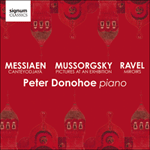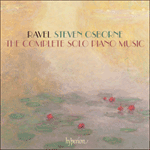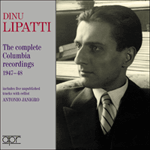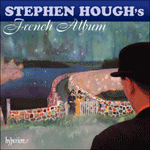In the five pieces entitled
Miroirs, written in 1905, Ravel’s compositional technique is clearly at work, but less patently than in the earlier works. The fast appoggiaturas in ‘Noctuelles’ and the sudden spurts of crescendo paint a picture of night moths flitting in the darkness, while the birds of ‘Oiseaux tristes’ utter their short–long call ‘in a very dark forest during the hottest hours of summer’. With ‘Une barque sur l’océan’ we emerge into the daylight. Here is a water piece that escapes the constraints of
Jeux d’eau, or at least gives the impression of doing so, riding on a surge of arpeggios from start to finish. Ravel explained that the character of the clown (gracioso) in ‘Alborada del gracioso’ was humorous, but with an edge to him—less well meaning than Beaumarchais’s Figaro—and no doubt the drier tone and lighter action of the Erard pianos Ravel favoured would have accentuated the sharpness of the arpeggiated ‘guitar’ chords and repeated notes. ‘La vallée des cloches’ is the only one of the five pieces that reflects a particular reality, the sound of midday bells in Paris. Ravel demanded that each bell should have its own timbre, ‘within a pianissimo which he could, in some mysterious way, produce without it sounding feeble’. When Viñes gave the first performance of the set on 6 January 1906, ‘Alborada’ was encored.
from notes by Roger Nichols © 2011
Dans les cinq pièces intitulées
Miroirs, composées en 1905, la technique de composition de Ravel est toujours là, mais de manière moins manifeste. Les appogiatures rapides dans «Noctuelles» et les brusques poussées de crescendo peignent un tableau de papillons de nuit voletant dans l’obscurité, alors que les oiseaux des «Oiseaux tristes» émettent leur appel court-long «dans la torpeur d’une forêt très sombre aux heures les plus chaudes de l’été». Avec «Une barque sur l’océan», on émerge dans la lumière du jour. Voici une pièce aquatique qui échappe aux contraintes des
Jeux d’eau, ou au moins en donne l’impression, portée par une montée d’arpèges du début à la fin. Ravel a expliqué que le caractère du clown (gracioso) dans l’«Alborada del gracioso» était plein d’humour, mais avec quelque chose de tendu—moins bien intentionné que le Figaro de Beaumarchais—et il ne fait aucun doute que le son plus sec et le mécanisme plus léger des pianos Erard qu’affectionnait tant Ravel devaient accentuer la netteté des accords de «guitare» arpégés et des notes répétées. «La vallée des cloches» est la seule de ces cinq pièces à refléter une réalité particulière, le son des cloches de midi à Paris. Ravel a demandé que chaque cloche ait son propre timbre «dans cette nuance pianissimo dont il avait le secret pour la faire sans mollesse». Lorsque Viñes a créé ce recueil le 6 janvier 1906, l’«Alborada» a été bissée.
extrait des notes rédigées par Roger Nichols © 2011
Français: Marie-Stella Pâris
In den fünf Stücken mit dem Titel
Miroirs, die 1905 entstanden, ist Ravels Kompositionstechnik noch spürbar, wenn auch weniger offenkundig. Die schnellen Appoggiaturen in „Noctuelles“ und die plötzlichen Crescendi stellen Nachtfalter dar, die in der Dunkelheit umherflattern, während die Vögel in „Oiseaux tristes“ „in der Benommenheit eines sehr düsteren Waldes in den heißesten Sommerstunden“ ihren kurz-lang-Ruf äußern. Mit „Une barque sur l’océan“ gelangen wir ans Tageslicht. Hierbei handelt es sich um ein Wasserstück, das nicht denselben Einschränkungen unterliegt wie die
Jeux d’eau, oder zumindest ist dies nicht offensichtlich, da es von Anfang bis Ende auf einer Welle von Arpeggien reitet. Ravel erklärte, dass die Figur des Clowns (gracioso) in „Alborada del gracioso“ humoristisch, jedoch nicht ganz harmlos sei—weniger wohlgesinnt als Beaumarchais’ Figaro—und der trockenere Ton und leichtere Anschlag der Erard-Flügel, die Ravel besonders schätzte, akzentuierten sicherlich die Schärfe der arpeggierten „Gitarren-Akkorde“ und Tonrepetitionen. „La vallée des cloches“ ist das einzige der fünf Stücke, in dem eine bestimmte Realität widergespiegelt wird—es handelt sich hierbei um die Mittagsglocken in Paris. Ravel verlangte, dass jede Glocke ihr eigenes Timbre haben sollte, „mit jenem Pianissimo, das er derartig beherrschte, dass es ohne jede Weichheit erklang“. Als Viñes den Zyklus am 6. Januar 1906 zum ersten Mal aufführte, spielte er „Alborada“ als Zugabe.
aus dem Begleittext von Roger Nichols © 2011
Deutsch: Viola Scheffel

 Musorgsky: Pictures from an exhibition; Ravel: Miroirs; Messiaen: Cantéyodjayâ
Musorgsky: Pictures from an exhibition; Ravel: Miroirs; Messiaen: Cantéyodjayâ Ravel: The Complete Solo Piano Music
Ravel: The Complete Solo Piano Music Dinu Lipatti - The complete Columbia recordings, 1947-1948
Dinu Lipatti - The complete Columbia recordings, 1947-1948 Stephen Hough's French Album
Stephen Hough's French Album
